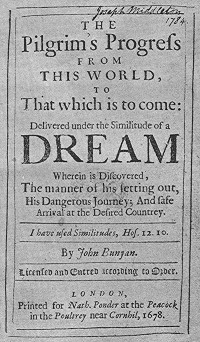The Pilgrim's Progress: A Journey Worth Taking?
Aaron Lewendon - Eden Bibles & Bible Study Specialist

‘A book over 100 years old’ - that was the remit for this month’s Eden reading challenge choice. Naturally, that is a broad selection. From the Bible onwards, there are enough books written to fill innumerable libraries. Some were forgotten, some were lost, and some survived and are read to this day. That act of survival, whenever one comes across a book with such longevity, must be questioned. Literary canons, it can often feel, are named so because those standing in their way are frequently shot down - even W.H. Auden wrote in The Dryer’s Hand that “Some books are undeservedly forgotten; none are undeservedly remembered.” - but this incredulous spirit, I believe, is key to understanding such an antiquarian text.
And so, the one question I want to raise in regards to this month’s book is:
Is John Bunyan’s The Pilgrim’s Progress worth reading today?

First published in 1678, The Pilgrim’s Progress (full title: The Pilgrim’s Progress from This World to That Which is to Come) is an oneiric narrative that follows Christian, a young man plagued by visions of imminent destruction, on his journey to the Celestical City where paradise and salvation await, situated at the cartological omphalos of the book.
But the course of the literary journey never does run smooth, as sloughs, jails, troubles and temptations all await Christian’s arrival. Along the way Christian meets several figures whose characteristics are literal embodiments of their own name (or who just have really mean parents). These include Pliable (who does what near-everybody tells him to do), Hopeful (ever the optimist), Evangelist (who tells Christian how he might be saved), Prudence (a big fan of old-fashioned morals), and a plethora of others both helpful and antagonistic. At no point are you ever in doubt about what these characters represent (more on that later).
The story of The Pilgrim’s Progress follows pretty closely to the standard formula of the fairytale (which, if you are interested, I highly recommend you read Vladímir Propp’s Morphology Of The Folk Tale, or The Seven Basic Plots by Christopher Booker): hero leaves home, receives calling, meets guide, encounters trouble (often related to hero’s actions), overcomes, succeeds or fails depending on the type of story.
On one level, there is a simplicity to the story that allows readers of all ages to comprehend the book’s meanings. But does the uncomplicated writing of the book hold up after several centuries?

It bears remembering the religious and historical climate the book was written in. John Bunyan was a Puritan preacher, and fiction was not held favourably amongst the Puritans. Literary complexity would have effectively led to the book potentially never seeing the light of day. Rather, to be championed by his own, The Pilgrim’s Progress needed to adopt the same tone as that of a sermon (where many of the book’s ideas were originally formed). The book needed to be, above all, an allegory.
Christian fiction is no stranger to allegory. A quick perusal through our own fiction department will confirm that allegorical fiction still being written to this day. These are novels which, whilst keeping the formula of fiction, keep their sights on the message they wish to convey. The Screwtape Letters, The Shadow Doctor, The Chronicles of Narnia, and The Shack all make sure the reader finishes the book with more than just the satisfaction that comes with a story well-told. There is a message, a reason for being, for each of these stories that serves to inform the reader’s beliefs. As an allegorical story, then, I would come to the following conclusion:
The Pilgrim’s Progress works better as a guide to allegorical fiction, rather than as an allegorical novel in its own rights.
Yes, there are messages, a series of small parables for dealing with moral, spiritual and emotional pitfalls that we all come across in faith, but these parables are simple and not designed for great discussion or revelation.
For example, Christian, not watching where he is walking, falls into the Slough of Despondency. The message? It’s easy to become despondent if we don’t keep an eye on our emotions. As a memorable depictions of these messages, though, the book certainly is visual: it just doesn’t contain the complexity of novels like The Shack that deliver a hefty emotional punch by exploring in depth the inner lives of its characters.
That’s also not to say other parts of the book haven’t aged. I would be lying if said I didn’t chuckle at the scene where Christian puts his fingers in his ears, and literally runs away from his family whilst crying ‘Life, life, eternal life’.
But, there is still a staying power in the book. The Pilgrim’s Progress does offer doors to discussing existential questions of identity and nature, as well as being a story of the hurdles to faith, and the lengths needed to go in order to follow God. Yes, whilst the book is simple, and does seem to be merely content with personifying the moral path of faith, it’s vivid storytelling and memorable settings do make The Pilgrim’s Progress a journey with taking. After all, as the exquisite Italo Calvino wrote in his essay ‘Why Read the Classics?’:
“A classic does not necessarily teach us anything we did not know before. In a classic we sometimes discover something we have always known”
The Pilgrim’s Progress lasts because its truths are as timeless as mythic storytelling they are painted with.
The Pilgrim's Progress by John Bunyan is avaliable to by in several editions from our Allegorical Fiction department.
.jpg)
Latest Blogs

Gifts
Finding Your Symbol of Faith: A Guide to Christian Cross Necklaces
Looking for the perfect symbol of faith? Explore our guide to Christian cross necklaces, from rustic wooden designs and sturdy men's chains to elegant silver pendants.

Gifts
The Best Christian Gifts for Under £20
Looking for a meaningful gift that won't break the bank? Explore our guide to the best Christian gifts under £20, from inspiring journals to beautiful home decor.

Gift Guide
15 Confirmation Gift Ideas for Boys and Girls
Celebrating a confirmation? Discover 15 meaningful gift ideas for boys and girls, from youth Bibles and jewellery to inspiring journals and keepsakes.

Bible
30+ Powerful Quotes About the Bible (For Inspiration in 2026)
Looking for inspiration? Discover a curated collection of the most powerful quotes about the Bible, from famous historical figures to modern theologians and Scripture itself.

Bibles
What is the "Standard" Bible for Christians?
Is there an "official" Bible that all Christians use? We explain the difference between the NIV, KJV, and ESV, and help you find the standard text for your church or personal reading.

Bible
"I Keep Failing to Read the Bible" – 5 Tips to Make the Habit Stick
Do you start a Bible reading plan only to quit a few weeks later? Stop the cycle of guilt. Here are 5 psychological tips and practical changes to help you build a Bible habit that actually lasts in 2026.
